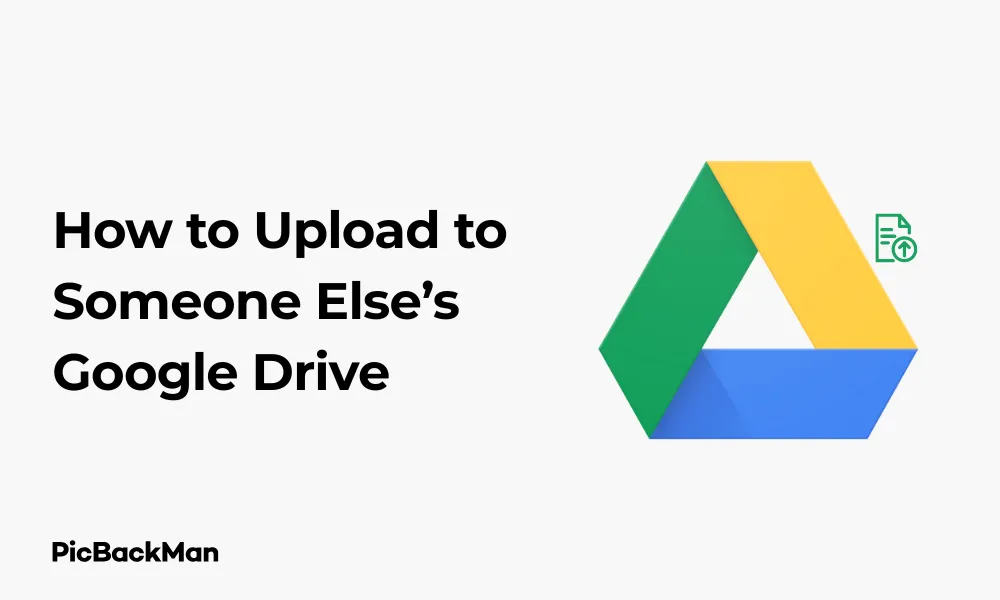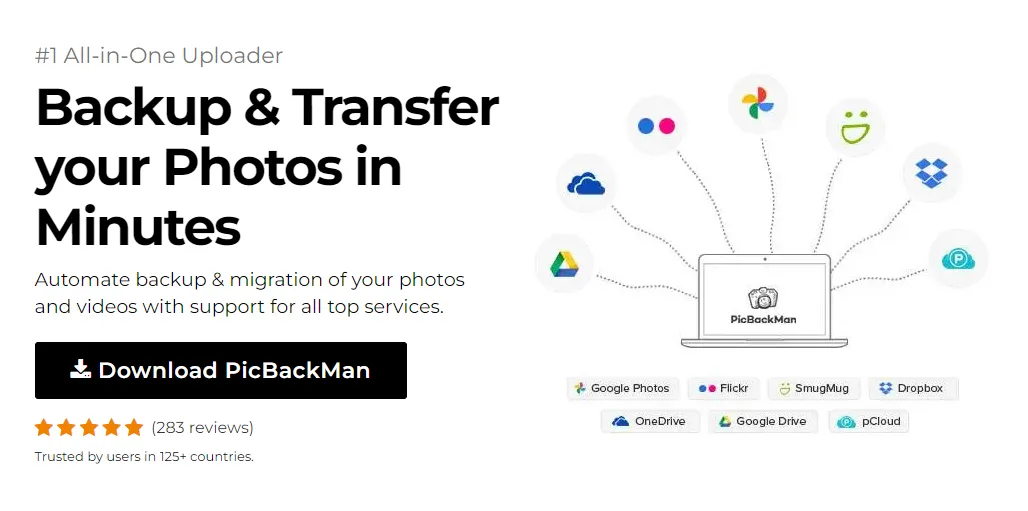
Why is it the #1 bulk uploader?
- Insanely fast!
- Maintains folder structure.
- 100% automated upload.
- Supports RAW files.
- Privacy default.
How can you get started?
Download PicBackMan and start free, then upgrade to annual or lifetime plan as per your needs. Join 100,000+ users who trust PicBackMan for keeping their precious memories safe in multiple online accounts.
“Your pictures are scattered. PicBackMan helps you bring order to your digital memories.”
How to Upload to Someone Else’s Google Drive [5 Easy Ways]


Sharing files with colleagues, friends, or family members has become essential in our digital world. Google Drive offers several ways to upload files directly to someone else's drive without complicated steps. Whether you're working on a team project, sending important documents, or sharing family photos, knowing how to upload to someone else's Google Drive can save you time and make collaboration much smoother.
In this guide, I'll walk you through five simple methods to upload files to someone else's Google Drive. Each method has its own advantages depending on your specific situation, so you can choose the one that works best for you.
Method 1: Using Shared Folders
One of the most straightforward ways to upload files to someone else's Google Drive is through shared folders. This method works well for ongoing collaboration and regular file sharing.
Steps to Upload Using Shared Folders
- Ask the folder owner to create a folder in their Google Drive
- Have them right-click on the folder and select "Share"
- They should enter your email address in the sharing dialog
- Make sure they select "Editor" permissions (not just "Viewer")
- Once you receive the invitation, open the shared folder
- You can now upload files directly to this folder
Benefits of Using Shared Folders
- Files appear directly in the other person's Drive
- Both parties can see and edit the files
- Good for long-term collaboration
- You can organize files within subfolders
Limitations to Consider
- The folder owner must initiate the sharing
- Files count against the folder owner's storage limit
- You need a Google account to access shared folders
Method 2: Direct File Sharing with Edit Access
If you already have a file in your Google Drive that you want to appear in someone else's Drive, you can share it with specific permissions that allow them to move it to their Drive.
Steps to Share Files with Edit Access
- Open your Google Drive and locate the file you want to share
- Right-click on the file and select "Share"
- Enter the recipient's email address
- Change the permission level to "Editor"
- Optional: Add a message explaining what you're sending
- Click "Send"
The recipient will receive an email notification with a link to the file. They can then open the file and use the "Add to My Drive" option to place it in their own Google Drive.
How to Move the File to Their Drive (Instructions for the Recipient)
- Open the shared file from the email link or your "Shared with me" section
- Click on the folder icon at the top of the screen
- Select "Add to My Drive"
- Choose where in your Drive you want to store the file
When to Use This Method
- Perfect for one-time file transfers
- Works well when you want to give them a copy of your file
- Good when you don't need to maintain the connection between files
Method 3: Using Google Drive File Stream for Teams
For organizations using Google Workspace (formerly G Suite), Google Drive File Stream provides an efficient way to upload files directly to shared team drives or folders.
Setting Up Google Drive File Stream
- Download Google Drive for desktop from the Google website
- Install the application on your computer
- Sign in with your Google Workspace account
- Wait for Drive to sync with your computer
Uploading to Someone Else's Drive
- Open File Explorer (Windows) or Finder (Mac)
- Navigate to the Google Drive section
- Find the shared drive or folder you have access to
- Drag and drop files directly into this location
- Wait for the files to sync (look for the green checkmark)
Advantages for Business Users
- Files are automatically synced across all team members
- Works like a normal folder on your computer
- Can upload multiple files or entire folders at once
- Maintains file structure during uploads
Method 4: Using Google Drive Request Files Feature
Google Drive offers a "Request Files" feature that allows others to upload files directly to your Drive. If you need to upload to someone else's Drive, you can ask them to set this up.
How to Set Up File Requests (For the Drive Owner)
- Go to Google Drive and navigate to the folder where you want to receive files
- Right-click on the folder and select "Google Forms" then "Request files"
- Set up the file request form with a title and description
- Configure options like requiring sign-in and file size limits
- Click "Send" and share the link with the people you want to receive files from
How to Upload Using a File Request Link
- Open the file request link sent to you
- Fill out any required information on the form
- Click "Add file" to select files from your computer
- You can add multiple files if needed
- Click "Submit" when you're done
The files will be uploaded directly to the folder specified by the Drive owner, with no need for you to have edit access to their Drive.
Benefits of File Requests
- No need for the uploader to have a Google account
- Files go directly to a specified folder
- The Drive owner can collect files from multiple people
- Great for collecting submissions or assignments
Method 5: Using Google Drive Transfer Ownership
If you need to give someone else complete control of a file or folder in your Drive, transferring ownership is the way to go.
Steps to Transfer Ownership
- Open Google Drive and find the file or folder you want to transfer
- Right-click on it and select "Share"
- Add the person's email address if they're not already a collaborator
- Make sure they have "Editor" access
- Click on the dropdown menu next to their name
- Select "Make owner"
- Confirm the transfer when prompted
What Happens After Ownership Transfer
Once ownership is transferred, the file or folder will count against the new owner's storage quota instead of yours. You'll still have access to the file unless the new owner changes your permissions.
Important Limitations to Know
- You can only transfer ownership to someone with a Google account
- Some file types have restrictions on ownership transfer
- You can't transfer ownership of files in a shared drive
- Once transferred, you can't take back ownership (the new owner must transfer it back)
Comparing All 5 Methods
| Method | Best For | Requires Google Account | Storage Counted Against | Ease of Use |
|---|---|---|---|---|
| Shared Folders | Ongoing collaboration | Yes | Folder owner | Easy |
| Direct File Sharing | One-time transfers | Yes | Original owner until moved | Easy |
| Drive File Stream | Business teams | Yes (Workspace) | Team Drive quota | Medium |
| File Requests | Collecting submissions | No | Request creator | Easy |
| Ownership Transfer | Permanent handover | Yes | New owner | Medium |
Tips for Successful Google Drive Sharing
Organizing Files Before Sharing
Before uploading files to someone else's Google Drive, take some time to organize them properly. This makes it easier for the recipient to find and use the files.
- Group related files in folders
- Use clear, descriptive file names
- Remove any unnecessary files
- Consider converting files to Google formats for better collaboration
Managing File Sizes
Google Drive has limits on file sizes and storage space. Keep these in mind when uploading to someone else's Drive:
- Individual file size limit: 5TB for most file types
- Google Docs, Sheets, and Slides have their own specific limits
- Compress large files or folders before uploading
- Consider using Google's native formats which don't count toward storage
Security Considerations
When uploading to someone else's Drive, keep these security practices in mind:
- Only share what's necessary
- Check permission settings before sharing sensitive information
- Consider password-protecting sensitive files before uploading
- Remember that shared files can sometimes be reshared by recipients
Troubleshooting Common Issues
Can't Upload Files
If you're having trouble uploading files to someone else's Drive, check these common issues:
- Verify you have the correct permission level (Editor, not just Viewer)
- Check your internet connection
- Make sure the file isn't too large
- Confirm the recipient's Drive isn't full
- Try a different browser or clear your cache
Files Not Appearing in the Other Person's Drive
Sometimes files don't show up as expected. Here's what to check:
- Confirm the file finished uploading (check for the green checkmark)
- Ask them to check their "Shared with me" section
- Verify you shared with the correct email address
- Have them refresh their Google Drive page
- Check if they need to accept the sharing invitation
Permission Issues
Permission problems are common when sharing Google Drive files:
- Make sure you're using the right sharing settings (Editor vs. Viewer)
- Check if their organization has restrictions on external sharing
- Verify if they're signed in with the correct Google account
- Try resharing the file with different settings
Quick Tip to ensure your videos never go missing
Videos are precious memories and all of us never want to lose them to hard disk crashes or missing drives. PicBackMan is the easiest and simplest way to keep your videos safely backed up in one or more online accounts.
Simply download PicBackMan (it's free!), register your account, connect to your online store and tell PicBackMan where your videos are - PicBackMan does the rest, automatically. It bulk uploads all videos and keeps looking for new ones and uploads those too. You don't have to ever touch it.
Advanced Google Drive Sharing Features
Setting Expiration Dates
If you want to limit how long someone has access to your files, you can set expiration dates:
- Share the file as usual
- Click on the dropdown next to the person's name
- Select "Give access"
- Click on "Access expires" and choose a date
- The person will lose access after that date
Preventing Downloads and Copying
For sensitive documents, you might want to prevent people from downloading or copying the content:
- Share the file with "Viewer" permissions
- Click the settings gear in the sharing dialog
- Uncheck "Viewers and commenters can see the option to download, print, and copy"
- Click "Save"
Using Link Sharing Effectively
Link sharing can be convenient but needs to be used carefully:
- Use "Restricted" for most business documents
- Only use "Anyone with the link" for non-sensitive information
- Consider changing link permissions after the necessary people have accessed the file
- Remember that links can be forwarded to others
Google Drive for Different User Types
Personal Users
If you're sharing files with friends or family:
- Shared folders work well for ongoing sharing (like family photos)
- Direct file sharing is good for one-time transfers
- Consider creating a dedicated folder structure for different types of sharing
Business Users
For professional environments:
- Use Shared Drives (formerly Team Drives) for department-wide collaboration
- Take advantage of Google Drive File Stream for desktop access
- Set clear naming conventions for shared files
- Use the file request feature for collecting documents from clients or team members
Educational Settings
Teachers and students can benefit from:
- File request forms for assignment submission
- Shared folders for class materials
- Ownership transfer for student projects
- Comment-only permission for feedback on work
Conclusion
Uploading files to someone else's Google Drive doesn't have to be complicated. With these five methods—shared folders, direct file sharing, Google Drive File Stream, file requests, and ownership transfer—you have options for virtually any situation. The right choice depends on your specific needs, how frequently you'll be sharing files, and whether you need ongoing collaboration.
Remember to consider factors like storage limits, permission settings, and the recipient's comfort level with Google Drive when choosing your method. By following the steps outlined in this guide, you can make file sharing a smooth and efficient process for everyone involved.
Google Drive continues to evolve with new features and improvements, so keep an eye out for updates that might make file sharing even easier in the future. With a little practice, you'll be a Google Drive sharing expert in no time!
Frequently Asked Questions
Can I upload files to someone's Google Drive without them knowing?
No, you cannot upload files to someone's Google Drive without their knowledge. All methods require either their permission (through sharing settings they control) or their active participation (by setting up file requests or shared folders). Google Drive is designed to maintain user privacy and control over their storage space.
Will files I upload to someone else's Drive count against my storage quota?
When you upload files to someone else's Drive through a shared folder or file request, those files count against the Drive owner's storage quota, not yours. However, if you're sharing a file from your Drive, it counts against your quota until ownership is transferred or the recipient makes their own copy.
What's the maximum file size I can upload to someone's Google Drive?
The maximum file size for uploads to Google Drive is 5TB per file, as long as it's not a Google Docs, Sheets, or Slides file (which have different limits). This limit applies regardless of whose Drive you're uploading to. However, the recipient must have enough available storage space to accommodate the files.
Can I upload folders with their structure intact to someone else's Drive?
Yes, you can maintain folder structures when uploading to someone else's Drive. The best methods for this are using shared folders or Google Drive File Stream, which preserve the folder hierarchy. When using file requests, you might need to compress folders first, as this feature is primarily designed for individual files.
How can I see what files I've shared with others or others have shared with me?
To view files you've shared with others, go to Google Drive and click on "Shared with others" in the left sidebar. To see what others have shared with you, click on "Shared with me." These sections help you keep track of all your shared files and manage permissions as needed.






